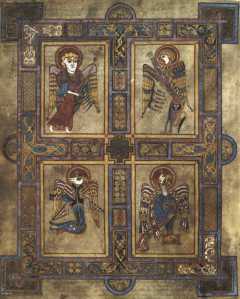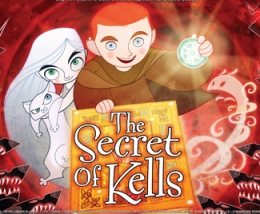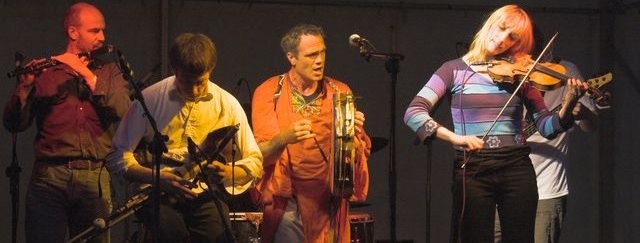
FolkWorld Issue 41 03/2010; Article by Walkin' T:-)M
Folk Music on the Silver Screen (4)
You Can't Find Out Everything from Books - The Secret of Kells

|
The Book of Kells is one of the most famous illuminated mediaeval manuscripts. The Secret of Kells is an animated feature film inspired by Ireland's national treasure. Its Academy Award Nomination is only appropriate.
|
Irish Music on the Silver Screen
Nostalgic traditional music put into the musical score
[The Quiet Man];
emigrants having a party with jigs and reels at the steerage deck
[Titanic];
a police officer patrolling to Clannad's Celtic mysticism
[Intermission];
an IRA attack to the rhythm of traditional dance music
[Some Mother's Son];
British soldiers marching out to a Chieftains soundtrack
[Rob Roy];
Ant soldiers singing we ants go marching one by one, hurrah, hurrah,
we slaughter termites just for fun, hurrah, hurrah
[Antz].
Only recently composer Hans Zimmer
described his Sherlock Holmes score as
the sound of the Pogues joining a Romanian orchestra.
There you have it. Irish music is everywhere.
Even The Commitments,
supposed to bring soul music to Dublin, can't do without a haunting Irish ballad
and lively Irish step dancing.
Here's some songs and tunes that can be heard on the silver screen, and there's probably more ...
Irish Musicians on the Silver Screen:
More Musicians on the Soundtrack:
Some Irish Songs on the Silver Screen:
Some Irish Tunes on the Silver Screen:
|
The Book of Kells is the most famous of a group of manuscripts in what is known as the Insular style, created from the 6th to the 9th century AD in monasteries with Irish, Scottish and Anglo-Saxon foundations. It comprehends the four Gospels of the New Testament plus various introductions and was transcribed approx. 800 AD. The name is derived from the Abbey of Kells in County Meath, Ireland, which was its home for much of the mediaeval period. It is widely believed that the book's production was begun at Iona Abbey and continued at Kells.
The text is accompanied by many full-page miniatures as well as decorated initials and small figures of humans, animals and mythical beasts, often tied into complicated knots, which appear throughout the text. The knot work has many parallels in Celtic metalwork and stone carving of the period, motifs that are still used today in jewellery and tattoos. The pigments for the colourful illustrations would have been imported from the Mediterranean and, in the case of the lapis lazuli, as far as Afghanistan.

Kells Abbey was plundered by Vikings in the 10th century. The earliest historical reference to
the Book of Kells can be found in 1007 AD; the Annals of Ulster
record that the great Gospel of Columkille, the chief relic of the Western
World, was wickedly stolen during the night from the western sacristy of the great stone church
at Cenannas on account of its wrought shrine. The manuscript was recovered a few months
later under a sod - only its gilded cover was gone.
It is generally believed that the great Gospel of Columkille is the Book of Kells.

Brendan: You can't find out ev-erything from books, you know.
Aidan: I think I read that once.
One millennium afterwards, The Secret of Kells (working title: Brendan and the Secret of Kells) is an Irish-Belgian-French animated feature film by Cartoon Saloon, an animation house from Kilkenny, Ireland, that premiered at last year's Berlin International Film Festival. Director Tomm Moore relates the creation of The Book of Kells from the perspective of 12-year-old Brendan, who is living with his uncle, the stern Abbot Callach Cellach (voice: Brendan Gleeson), at Kells Abbey.
The Abbot is preoccupied with the fortification of Kells against the invading Vikings. Brendan’s life changes when the master illuminator Aidan arrives with the famous book as a refugee from Iona. Brendan is captivated by the art of decoration and illustration. To complete the book, Aidan needs certain berries to derive colour from. Brendan slips away into the woods where he meets the enchanting fairy girl Aisling and had eventually to fight the demon Crom Cruach.

Whereas the narrative of the film is rather straightforward and predictable, the visuals are a feast for the eye. The stylised cartoons are directly inspired by the Book of Kells’ illustrations. The haunting soundtrack had been created by Bruno Coulais, one of the most sought-after composers of French film music.
Coulais' music can be heard in blockbusters such as Les rivières pourpres [The Crimson Rivers, 2000] and Vidocq [2000], TV series such as Le comte de Monte Cristo [The Count of Monte Cristo, 1998] and Balzac [1999], and docu features such as Le peuple migrateur [Winged Migration, 2001] and Oceans [2009].
His musical style is changing from one film to another, but often there is a certain affinity for world music and mixing different musical cultures. While Bruno Coulais composed and orchestrated the soundtrack, the music is performed by members of the Irish band Kíla, namely Colm O Snodaigh (flute, whistles), Eoin Dillon (uilleann pipes), Dee Armstrong (fiddle, viola) and Rossa O Snodaigh and Lance Hogan (percussion).

Kíla @ FolkWorld: FW#4, #19, #26, #26, #26, #30, #32, #33, #33, #34, #34, #35, #40
|
Bruno Coulais' soundtrack covers the full spectrum of emotions, and the delivery is opposed to the fireworks of Kíla's traditional Irish / world beat amalgam. The music should have been nominated for an Academy Award (as the film is nominated for Best Animated Feature Film).
Kíla already had a guest appearance as a band in the short film Olive [2003], and before that they created the soundtrack to a theatre production of the BBC TV show Monkey! [2001]. For The Secret of Kells, Colm O Snodaigh and Dee Armstrong composed an additional piece. There is also Rossa's tune "Epicy" from the "Lemonade & Buns" album (2000) and Colm's "Cardinal Knowledge" from "Gambler's Ballet" (2007).
Kells Abbey was dissolved in the 12th century AD, the Book of Kells remained in the then parish church until 1654. When Cromwell's cavalry was quartered therein, it was sent to Dublin for safekeeping. The book has remained ever since at Trinity College and has been on display to the public in the Old Library since the 19th century, a popular tourist destination today. The library usually displays two of the current four volumes at a time, one showing a major illustrated page, the other opened at two text pages with smaller decorations.
Folk Music on the Silver Screen: |
Photo Credits:
(1) Book of Kells, Folio 27v containing the symbols of the Four Evangelists
(by Wikipedia);
(2)-(4) The Secret of Kells,
(5) Kíla
(from website);
(6) Brendan Gleeson (unknown).
|
To the German FolkWorld |
© The Mollis - Editors of FolkWorld; Published 03/2010
All material published in FolkWorld is © The Author via FolkWorld. Storage for private use is allowed and welcome. Reviews and extracts of up to 200 words may be freely quoted and reproduced, if source and author are acknowledged. For any other reproduction please ask the Editors for permission. Although any external links from FolkWorld are chosen with greatest care, FolkWorld and its editors do not take any responsibility for the content of the linked external websites.
